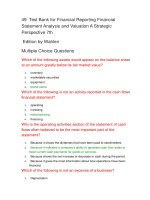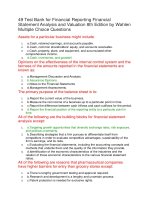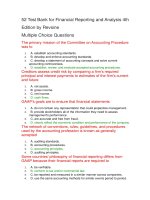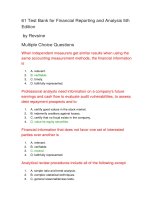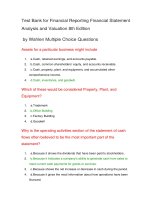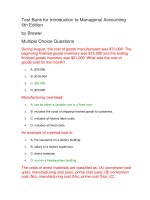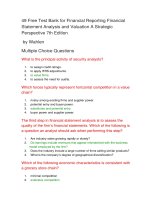61 test bank for financial reporting and analysis 5th edition
Bạn đang xem bản rút gọn của tài liệu. Xem và tải ngay bản đầy đủ của tài liệu tại đây (79.11 KB, 14 trang )
61 Test Bank for Financial Reporting and Analysis 5th
Edition
by Revsine
Multiple Choice Questions
When independent measurers get similar results when using the
same accounting measurement methods, the financial information
is
1.
2.
3.
4.
A. relevant.
B. verifiable.
C. timely.
D. faithfully represented.
Professional analysts need information on a company's future
earnings and cash flow to evaluate audit vulnerabilities, to assess
debt repayment prospects and to
1.
2.
3.
4.
A. certify good values in the stock market.
B. indemnify creditors against losses.
C. certify that no fraud exists in the company.
D. value its equity securities.
Financial information that does not favor one set of interested
parties over another is
1.
2.
3.
4.
A. relevant.
B. verifiable.
C. neutral.
D. faithfully represented.
Analytical review procedures include all of the following except
1.
2.
3.
4.
A. simple ratio and trend analysis.
B. complex statistical techniques.
C. general reasonableness tests.
D. comparison of the company's reported financial results to benchmarks
established by the SEC.
The ability to raise additional cash by selling assets, issuing
stock, or borrowing more is
1.
2.
3.
4.
A. financial flexibility.
B. a credit risk indicator.
C. a stock price predictor.
D. one way to project earnings.
Companies that have projected operating cash flows that are
more than sufficient to meet debt payments are
1.
2.
3.
4.
A. financially flexible.
B. good credit risk companies.
C. undervalued.
D. overvalued.
Relevant financial information
1.
2.
3.
4.
A. is free from bias and error.
B. is measured in a similar manner among different companies.
C. can be independently verified.
D. is capable of making a difference in a decision.
To achieve faithful representation, the financial information must
be
1.
2.
3.
4.
A. consistent, unbiased, and relevant.
B. relevant, comparable, and timely.
C. relevant, consistent, and timely.
D. complete, neutral, and free from material error.
All financial statements:
1.
2.
3.
4.
A. provide a picture of the company at a moment in time.
B. describe changes that took place over a period of time.
C. help to evaluate what happened in the past.
D. contain most up to date information about the company.
Financial information that is provided to decision makers before it
loses its capacity to influence their decisions is
1.
2.
3.
4.
A. neutral.
B. verifiable.
C. timely.
D. consistent.
Investors and analysts are sometimes urged to ignore traditional
GAAP numbers and instead focus on nonstandard "pro forma"
numbers because_______.
1.
A. the political compromises made to achieve consensus when issuing
FASB pronouncements lead to inaccurate portrayals of underlying events.
2. B. management believes the pro forma numbers portray the company in a
better light.
3. C. the pro forma numbers are closer to those reported under international
reporting standards.
4. D. pro forma numbers are easier to understand.
Creditors assess credit risk by comparing a firm's required
principal and interest payments to estimates of the firm's current
and future
1.
2.
3.
4.
A. net assets.
B. gross income.
C. net income.
D. cash flows.
A company's financial statements reflect information about
1.
2.
3.
4.
A. future projections of sales, expenses, and other future economic events.
B. product information and competitive positions.
C. the general economy of the industry in which the company operates.
D. economic events that affect a company that can be translated into
accounting numbers.
The type of analysis that does not concern itself with financial
statement numbers is
1.
2.
3.
4.
A. valuation analysis.
B. efficient market analysis.
C. fundamental analysis.
D. technical analysis.
Financial information capable of making a difference in a decision
is
1.
2.
3.
4.
A. relevant.
B. verifiable.
C. consistent.
D. neutral.
A company's financial statements can be used for all of the
following purposes except
1.
2.
3.
4.
A. as a scorecard on the company's social responsibility.
B. as a management report card.
C. as an early warning signal.
D. as a measure of accountability.
A firm's financial statements contain trends that give users insight
into the firm's
1.
2.
3.
4.
A. future market share.
B. position within its industry.
C. profitability, productivity, and liquidity.
D. current market price for common and preferred stock.
If a company fails to disclose information about a lawsuit because
it might be embarrassing to the company, it is violating
1.
2.
3.
4.
A. relevance.
B. verifiability.
C. neutrality.
D. timeliness.
Investors who presume that they have no insights about company
value beyond the current market price and use financial
statement data to assess firm-specific variables believe in the
1.
2.
3.
4.
A. market-to-market hypothesis.
B. efficient market hypothesis.
C. fundamental market hypothesis.
D. technical market hypothesis.
When a borrower violates a loan covenant that requires minimum
achievement of an accounting measure in the financial
statements, the lender can
1.
2.
3.
4.
A. immediately seize the loan collateral.
B. fire the chief operating officer of the borrower.
C. report the borrower to the IRS.
D. call for immediate repayment of the loan.
Business enterprises enter into many different types of contracts.
Examples of such contracts that often contain language that
refers to verifiable financial statement numbers include all of the
following except
1.
2.
3.
4.
A. royalty contracts with inventors.
B. sales contracts with customers.
C. compensation contracts with managers.
D. debt contracts with bankers.
Employees demand financial statement information because the
firm's performance is often linked to all of the following except
1.
2.
3.
4.
A. negotiated increases in union contracts.
B. social security benefits.
C. pension plan benefits.
D. employee profit sharing.
Investors who follow a fundamental analysis approach
1.
2.
A. determine the value the company's assets would yield if sold individually.
B.estimate the value of a stock by assessing the amount, timing, and
uncertainty of future cash flows that will accrue to the issuing company.
3.
C. assess the company's ability to meet its debt-related financial
obligations.
4. D. assess the company's ability to raise additional cash by selling assets,
issuing stock, or borrowing more.
The section of published reports of public companies that
includes a description of the company's business risks, results of
operations, financial condition, and future plans for the company
is known as the
1.
2.
3.
4.
A. management's discussion and analysis.
B. management representation letter.
C. president's message.
D. board of directors' analysis.
The market analysis known as fundamental analysis
1.
A. predicts future trends in the financial drivers of a company's success or
failure.
2. B. relies on price and volume movement of stock.
3. C. has no insights about company value beyond current market price.
4. D. uses microeconomic data to forecast stock values.
The type of analysis that uses financial statements to assess
valuation of current market price is
1.
2.
3.
4.
A. valuation analysis.
B. efficient market analysis.
C. fundamental analysis.
D. technical analysis.
Being verifiable and neutral is part of what makes financial
information
1.
2.
3.
4.
A. useful.
B. consistent.
C. comparable.
D. relevant.
The amounts of executive compensation and bonuses are often
determined by
1.
2.
3.
4.
A. auditor's recommendations.
B. evaluations by subordinates.
C. company contracts.
D. industry guidelines.
Investors who compare a firm's discounted future cash flows to
the current market price of a stock are using the
1.
A. efficient market hypothesis.
2.
3.
4.
B. market-to-market approach.
C. fundamental analysis approach.
D. technical analysis approach.
61 Free Test Bank for Financial Reporting and Analysis
5th Edition by Revsine Multiple Choice Questions Page 2
When a financial statement contains omissions or misstatements
that would alter the judgment of a reasonable person, it violates
1.
2.
3.
4.
A. neutrality.
B. consistency.
C. conservatism.
D. materiality.
One financial disclosure cost is the possibility that competitors
may use the information to harm the company providing the
disclosure. All of the following disclosures might create a
competitive disadvantage except
1.
A.detailed information about company operations, such as sales and cost
figures for individual product lines.
2. B. information about the company's technological and managerial
innovations.
3. C. information on the company's level of spending on research and
development.
4. D. details about the company's strategies, plans and tactics.
IFRS frequently
1.
2.
A. upon issue are automatically approved for any foreign listed company.
B. permit only one accounting treatment for similar business transactions
and events to promote comparability.
3. C. allow firms less latitude when compared to U.S. GAAP.
4. D. follow a more generalized overview approach than do U.S. GAAP
counterpart standards.
Some countries' philosophy of financial reporting differs from U.S.
GAAP because their financial reports are required to
1.
2.
3.
4.
A. be verifiable.
B. conform to tax and/or commercial law.
C. be reported and measured in a similar manner across companies.
D. use the same accounting methods for similar events period to period.
Using the same accounting methods to record and report similar
events from period to period demonstrates
1.
2.
3.
4.
A. consistency.
B. comparability.
C. neutrality.
D. faithful representation.
The growth of global investing has spurred development of
worldwide accounting standards that are written by the
1.
2.
3.
4.
A. American Institute of Certified Public Accountants.
B. Institute of Global Auditors.
C. Global Committee on Accounting Standards.
D. International Accounting Standards Board.
The ASC uses a structure in which the FASB's authoritative
accounting guidance is organized into all of the following except
1.
2.
3.
4.
A. chapters.
B. topics.
C. sections.
D. paragraphs.
The Financial Accounting Standards Board has responsibility for
the establishment of U. S. accounting standards and
1.
2.
3.
4.
A. full statutory power to enforce compliance with GAAP.
B. authority from the SEC to enforce compliance with GAAP.
C. no authority or responsibility to enforce compliance with GAAP.
D. responsibility imposed by AICPA to enforce compliance with GAAP.
The network of conventions, rules, guidelines, and procedures
used by the accounting profession is known as generally
accepted
1.
2.
3.
4.
A. auditing standards.
B. accounting procedures.
C. accounting principles.
D. auditing principles.
International accounting rules are currently established by the
1.
2.
3.
4.
A. IASC.
B. IASB.
C. FASB.
D. none of the above.
Which one of the following types of disclosure costs is the cost of
disclosing the company's pricing strategies?
1.
2.
A. Political cost
B. Litigation cost
3.
4.
C. Competitive disadvantage cost
D. Information collection, processing, and dissemination cost
The SEC has issued a proposed roadmap for the adoption of
IFRS by U.S. public companies, specifying adoption by the end
of
1.
2.
3.
4.
A. 2011.
B. 2014.
C. 2015.
D. The roadmap does not specify a "date certain" for adoption.
Financial reporting philosophies differ across countries. These
philosophies evolve from and reflect several factors including all
of the following except
1.
2.
3.
4.
A. the language(s) spoken in the country.
B. the specific political institutions within the country.
C. the specific financial institutions within the country.
D. the country's social customs.
When financial information is measured and reported in a similar
manner across different companies in the same industry it is
1.
2.
3.
4.
A. consistent.
B. comparable.
C. neutral.
D. faithfully represented.
A company manages a large portfolio of marketable securities
and sells only stocks with substantial gains in poor income years
or sells only stocks with substantial losses in good income years.
This strategy is an indication of
1.
2.
3.
4.
A. securities fraud.
B. unstable portfolio management.
C. income smoothing.
D. violating security trading laws.
ASC content is organized
1.
2.
A. alphabetically by topic.
B. in chronological order based on the issue date of the major
pronouncement on which the content is based.
3. C. without regard to the original standard from which the content was
derived.
4. D. in the manner prescribed by the IASB.
Companies needing to access new and ever larger sources of
capital in response to increased international competitiveness
face a severe disadvantage if their financial reporting
1.
2.
3.
4.
A. is in accordance with IFRS.
B. is in accordance with U.S. GAAP.
C. is based on a commercial and tax law approach.
D. is based on an economic performance approach.
In 2009, the FASB completed a five-year effort to distill the
existing GAAP literature into a single database known as
1.
2.
3.
4.
A. the accounting standards database.
B. international financial reporting standards.
C. the converged accounting standards.
D. the accounting standards codification.
When a company changes from straight-line to the declining
balance method of accounting for depreciation, the financial
statements lack
1.
2.
3.
4.
A. comparability.
B. consistency.
C. neutrality.
D. faithful representation.
IFRS are
1.
2.
3.
4.
A. built on broad principles.
B. rules-based.
C. narrowly defined, detailed standards.
D. seldom different than those issued by the FASB.
Depending on the home-country of a reporting entity, historically
(e.g., pre-IFRS) its financial statements might have been
1.
A. intended to capture and reflect the underlying performance and condition
of the reporting entity.
2. B. in conformity with mandated laws or detailed tax rules.
3. C. either a. or b.
4. D. none of the above.
Financial statements follow
1.
2.
A. rigid guidelines that require specific adherence to regulated procedures.
B. generally accepted guidelines that allow management to choose among
different procedures.
3. C. general guidelines with little choice among different procedures.
4. D. legal requirements for uniform presentation and disclosure.
Companies offering higher risk securities have incentives to mask
their true condition by
1.
2.
3.
A. supplying overly optimistic financial information.
B. not having their financial statements audited.
C. listing on foreign exchanges where reporting requirements are less
stringent than those in the U.S.
4. D. including testimonials from well known executives in their financial
statements.
Identify the correct order of the three steps constituting the
FASB's "due process" procedure.
1.
2.
3.
4.
A. Public-hearing stage, exposure-draft stage, and voting stage.
B. Discussion-memorandum stage, public-hearing stage, and voting stage.
C. Exposure-draft stage, discussion-memorandum stage, and voting stage.
D. Discussion-memorandum stage, exposure-draft stage, and voting stage.
The Securities and Exchange Act of 1934 required all publicly
traded firms to
1.
2.
3.
A. purchase insurance against corporate bankruptcy.
B. register with an authorized stock exchange.
C. provide annual financial statements audited by independent
accountants.
4. D. file balance sheets, income statements, and statements of cash flow with
the SEC each year.
GAAP's goals are to ensure that financial statements
1.
2.
A. do not contain any representation that could jeopardize management.
B. provide stockholders all of the information they need to assess
management's performance.
3. C. are accurate and free from fraud.
4. D. clearly reflect the economic condition and performance of the company.
Timeliness is a qualitative characteristic of accounting information
that indicates that information should be provided to users
1.
2.
3.
4.
A. within one month after the close of the books.
B. before it loses its capacity to influence their decisions.
C. before statutory deadlines.
D. every month.
It is common for shareholders to initiate litigation when
1.
2.
3.
A. the company reports record profits, but does not declare dividends.
B. there's a sudden drop in stock price.
C. the company introduces new products that are found to be harmful to the
environment.
4.
D.rumors about the company appear in the media that, if true, would result
in slower growth in future profits.
Which one of the following has statutory authority to determine
accounting rules?
1.
2.
3.
4.
A. American Institute of Certified Public Accountants
B. State Boards of Accountancy
C. Securities and Exchange Commission
D. Financial Accounting Standards Board
GAAP's flexibility in its reporting standards allows companies to
1.
2.
3.
4.
A. smooth reported earnings over several reporting periods.
B. change accounting estimates to meet target sales or earnings.
C. change accounting principles to improve reported earnings.
D. avoid adopting specific accounting techniques and reporting procedures.
Common justifications for changing accounting methods include
all of the following except:
1.
2.
3.
4.
A. to conform to industry practice.
B. to more accurately represent the company's activities.
C. a new pronouncement by the FASB necessitated the change.
D.the company's financial position appears significantly better when
reported under the new method than under the old one.
If the financial reporting environment were unregulated,
disclosure would occur voluntarily
1.
A.as long as other companies in the reporting company's industry
voluntarily disclosed financial information.
2. B. only to analysts that the company believes will report favorably on the
company's prospects.
3. C. only when managers wanted to raise additional capital.
4. D. as long as the incremental benefits to the company from supplying
financial information exceeded the incremental costs of providing the
information.

